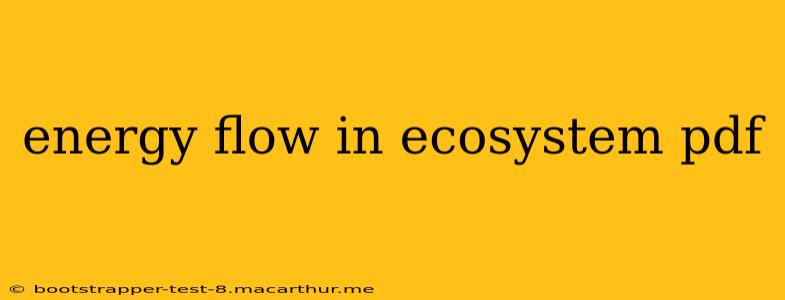Energy Flow in Ecosystems: A Comprehensive Guide
Energy flow in ecosystems is a fundamental concept in ecology, describing how energy moves through different trophic levels within a community of living organisms. Understanding this process is crucial for comprehending the interconnectedness of life on Earth and the delicate balance of natural systems. This guide explores the key aspects of energy flow, addressing common questions and providing a detailed overview of this vital ecological process.
What is energy flow in an ecosystem?
Energy flow in an ecosystem refers to the movement of energy from one organism to another through the food web. It begins with primary producers (autotrophs), primarily plants, which capture solar energy through photosynthesis. This energy is then transferred to consumers (heterotrophs) – herbivores, carnivores, and omnivores – through feeding relationships. Each step in the food chain represents a trophic level, with energy being lost as it moves up the chain. This loss is primarily due to respiration, heat loss, and the inefficiency of energy transfer during consumption.
How does energy flow through the trophic levels?
Energy flows through trophic levels in a unidirectional manner, meaning it moves in one direction only—from the sun, through producers, and then through various consumers. The process can be visualized as a pyramid, with producers forming the base, followed by primary consumers (herbivores), secondary consumers (carnivores that eat herbivores), and tertiary consumers (carnivores that eat other carnivores).
-
Producers (Trophic Level 1): These organisms, mainly photosynthetic plants, algae, and some bacteria, convert solar energy into chemical energy through photosynthesis. This energy is stored in organic molecules like carbohydrates, lipids, and proteins.
-
Primary Consumers (Trophic Level 2): Herbivores obtain energy by consuming producers. Examples include rabbits, deer, grasshoppers, and zooplankton.
-
Secondary Consumers (Trophic Level 3): Carnivores that feed on herbivores. Examples include snakes, foxes, owls, and some fish.
-
Tertiary Consumers (Trophic Level 4 and higher): These are top predators that feed on other carnivores. Examples include lions, eagles, sharks, and killer whales.
-
Decomposers: Bacteria and fungi play a vital role in breaking down dead organic matter, releasing nutrients back into the ecosystem and completing the cycle. They obtain energy from the breakdown of organic molecules.
What are the different types of ecological pyramids?
Ecological pyramids graphically represent the energy flow within an ecosystem. Three main types exist:
-
Pyramid of Energy: This pyramid always shows a decrease in energy at each trophic level. It is the most accurate representation of energy flow, as it accounts for energy loss at each stage.
-
Pyramid of Numbers: This represents the number of organisms at each trophic level. It can be inverted in some cases, such as in a parasitic relationship where many parasites feed on a single host.
-
Pyramid of Biomass: This pyramid represents the total mass of living organisms at each trophic level. Similar to the pyramid of numbers, it can also be inverted in certain situations.
What is the 10% law of energy transfer?
The 10% law, a simplified rule of thumb, suggests that only about 10% of the energy available at one trophic level is transferred to the next. The remaining 90% is lost as heat, used for metabolic processes, or remains unconsumed. While not universally precise, this principle highlights the significant energy loss during trophic transfers.
How does energy flow affect the structure and function of an ecosystem?
The flow of energy dictates the structure and function of an ecosystem. The amount of energy available at each trophic level determines the biomass and population size of organisms at that level. Disruptions to energy flow, such as habitat destruction or pollution, can significantly impact the entire ecosystem. For example, a reduction in producers can lead to a decline in herbivore populations, impacting the entire food web.
What are some examples of energy flow in different ecosystems?
Energy flow varies across different ecosystems. In a grassland ecosystem, grass (producer) is consumed by grasshoppers (primary consumer), which are then consumed by frogs (secondary consumer), and finally, snakes (tertiary consumer). In a marine ecosystem, phytoplankton (producer) are consumed by zooplankton (primary consumer), which are then consumed by small fish (secondary consumer), and finally, larger fish (tertiary consumer).
What are the implications of energy flow for human activities?
Understanding energy flow is crucial for sustainable resource management. Overexploitation of resources at any trophic level can disrupt the ecosystem's energy balance and lead to ecological damage. Sustainable practices consider the energy flow within an ecosystem and aim to minimize negative impacts on the natural balance.
This comprehensive overview of energy flow in ecosystems aims to provide a strong foundational understanding. While further exploration is encouraged for a deeper dive, this guide provides a solid base for grasping this essential ecological concept. Remember to consult additional resources and research for specific details related to particular ecosystems.
